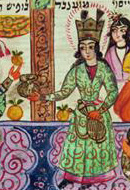Purim Puzzles

Purim, Judaism's strangest holiday (which this year falls on March 20), is prescribed by what may be the strangest book in the Hebrew Bible, the scroll (m'gilah) of Esther. Two public readings of the book, one at night and the other in the morning, tell a story of Persian palace intrigue in the fifth century B.C.E., a recitation accompanied by the holiday's decidedly unspiritual noisemaking, tippling, and masquerade.
Esther differs markedly from the rest of the Bible in that neither God nor a prophet speaking in His name saves the Jewish people. Rather, the genocidal plans of King Ahasueras's evil counselor Haman are foiled by the feminine wiles of the Jewish Queen Esther, the wisdom and sterling character of her uncle Mordecai, and a series of highly improbable coincidences. Not only is God absent from the book, but so is any mention of the land of Israel, the Jerusalem Temple, prayer, or other clearly Jewish religious practice.
How such a naturalistic depiction of deliverance made it into the Bible remains a puzzle, and the fact that Esther is the one biblical book absent from the Dead Sea Scrolls suggests that not all Jews in late antiquity thought it belonged there. Once it did get in, the rabbis employed midrash, their peculiarly ingenious exegetical method, to find God at each of the story's turning points and to square the behavior of the Jewish characters—even Esther's intermarriage to a Persian king—with normative Jewish law.
As for academic scholarship, the recent trend is to pronounce the narrative empty of the slightest shred of historical truth. Most researchers consign the scroll to the genres of satire and farce; the anthropologically-minded among them categorize the holiday of Purim as a Jewish version of carnival, the end-of-winter feast, à la Mardi Gras, when conventional restrictions on behavior are loosened and anything goes. Not to be outdone, many feminist critics have weighed in to condemn Esther's stereotypically seductive manipulation of men, and blame her for leading generations of little Jewish girls to dress up like her on Purim and act like her when they are grown.
Now an impressive reading of the m'gilah with fresh eyes, free of midrash on the one hand and of scholarly/trendy categories on the other, has come from David Fohrman, a modern-Orthodox rabbi. Proprietor of a user-friendly website, Fohrman is a sought-after lecturer whose extensive Jewish knowledge is capped by rabbinic training and a Johns Hopkins-honed mastery of textual close reading. His combination of skills is deployed to good effect in The Queen You Thought You Knew.
Uninterested in the origins of the text or in theories of composition, but unwilling to dismiss it as farce, Fohrman takes the Scroll of Esther as it is, a work with its own literary integrity. He then proceeds to ask difficult questions. Why, for instance, doesn't King Ahasueras show the least bit of curiosity about the ethnic origin of Esther, his new queen? Why, after the execution of Haman in chapter seven and the subsiding of the threat of anti-Jewish genocide, does the story continue for three more chapters, replete with killings by the Jews of more and more of their enemies—a display of apparent bloodlust that has furnished grist for the mills of anti-Semites at least as far back as Martin Luther? Why is so much detail lavished on the hangings of Haman and his seven sons, and then to the spectacle of Mordecai's public appearance in noble garb?
Fohrman finds answers in the text itself—and the proof of their plausibility, at least for this reader, lies in how obvious they seem once he explains them. Thus: the king of a recently unified empire would naturally prefer a consort not identified with any one of its 127 states; the Jews needed three more chapters to repel their enemies because even after the execution of Haman, Ahasueras had declined to annul Haman's decree but only allowed the Jews to defend themselves; the public hangings and Mordecai's carefully staged moment of glory were elements in a public-relations campaign to create the impression that the central government actively favored the Jews, and thereby to convince minor officials throughout the empire to line up on their side.
Fohrman's focus on the text has yet another dimension. He finds in it a number of key phrases that appear in earlier books of the Bible, notably Genesis and Numbers. Their deployment by the author of Esther, he argues, is not accidental. These echoing passages help Fohrman solve some knotty problems, including why the holiday came to be named not for the final Jewish victory but for the pur, the lot cast by Haman to decide the day on which the Jews would die.
Taken together, the network of intra-biblical allusions suggests to Fohrman a new understanding of the purpose of the scroll as a whole. Its "narrative arc," he concludes, "is more expansive than we thought." In a book placed toward the end of the scriptural canon, Esther and Mordecai "redeem . . . a moment from the dawn of biblical history."
The Queen You Thought You Knew is hardly flawless. While Fohrman's readings are generally convincing, he sometimes carries his points too far, twisting the text to confirm insights that are suggestive but not quite proved. More annoying is the writing, a folksy and humorous conversational style that, although it clearly contributes to his popularity as a lecturer, does not transfer well to the printed page where it can come across as cloying and even juvenile.
Nevertheless, anyone seeking a sophisticated and convincing interpretation of Esther that arises out of the Bible itself, devoid of midrashic or academic distraction, will find it here.
Lawrence Grossman is the editor of the American Jewish Year Book.
This is incorrect as Mordecai is the first cousin of Queen Esther - not her uncle. (Source: Esther 2:7)
Quite the Purim switcheroo (that's another Orthodox reference. See how easy it it?)
Comments are closed for this article.




